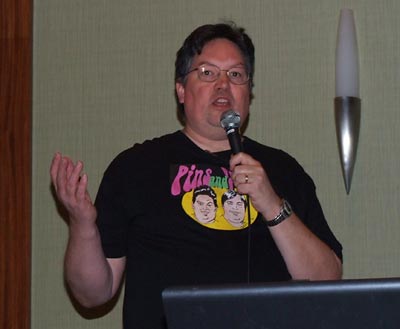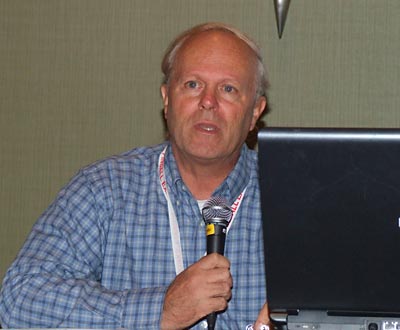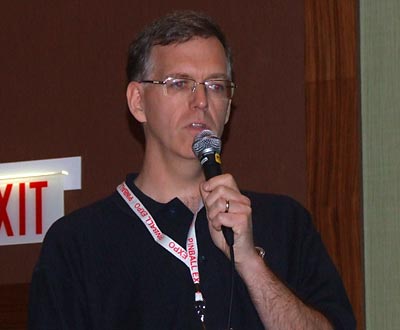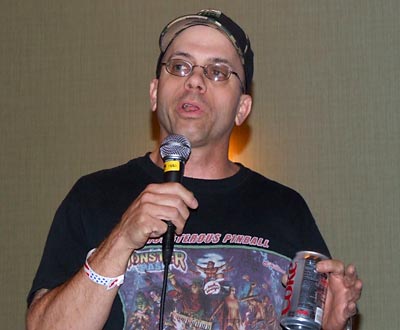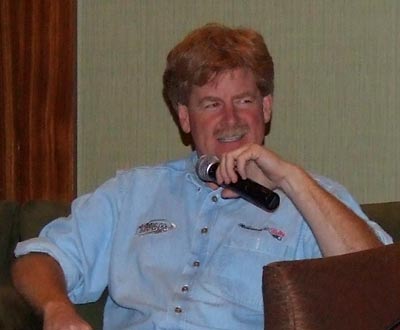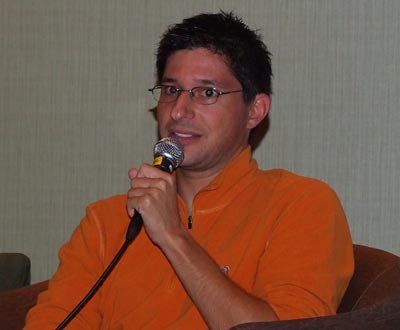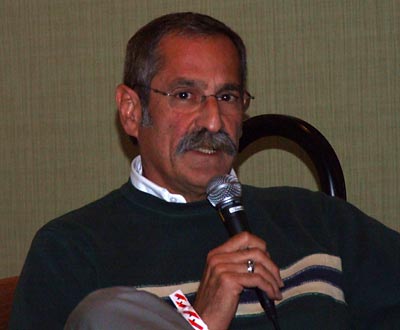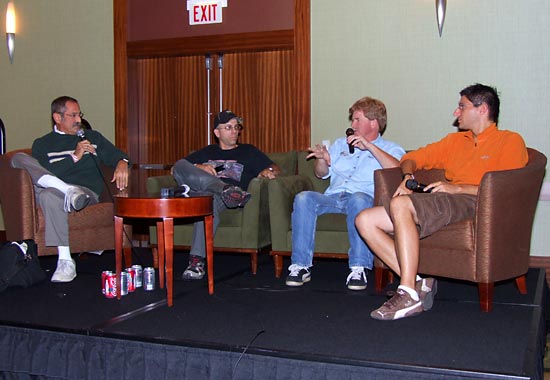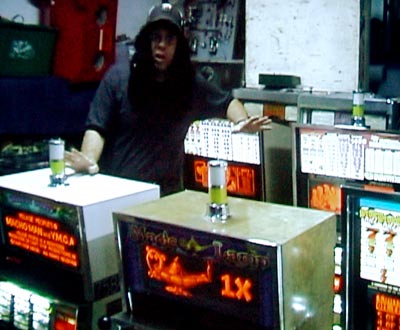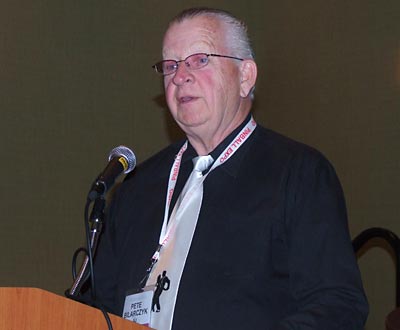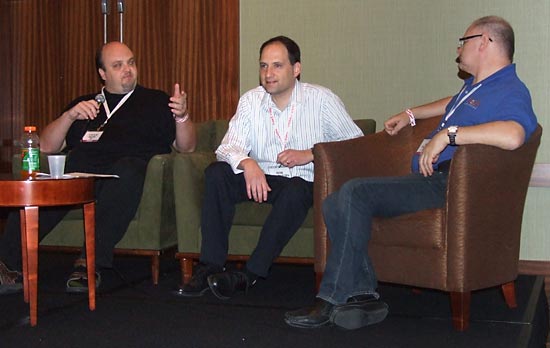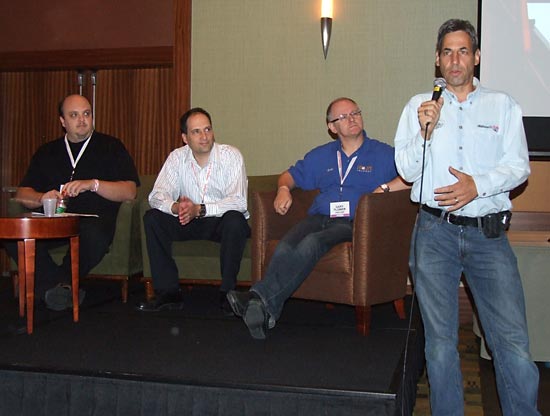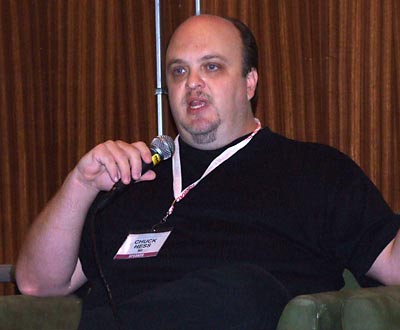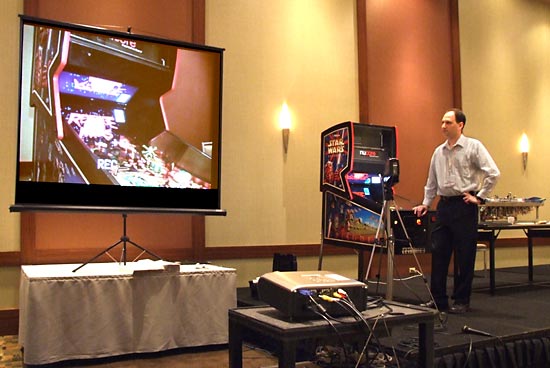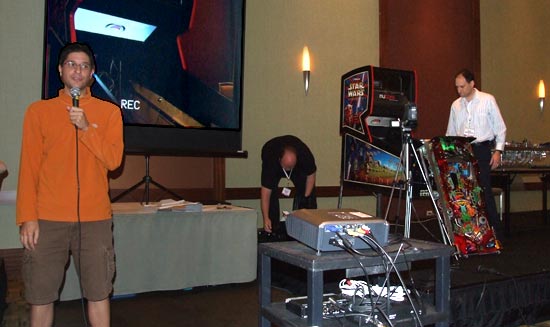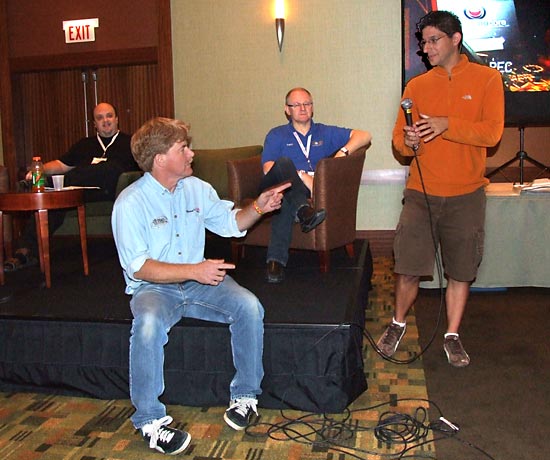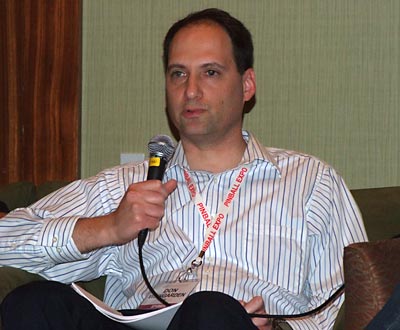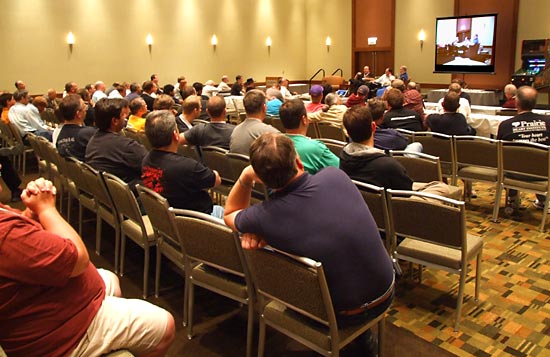| PINBALL EXPO 2008 |
| Date: 1st - 5th October 2008. Welcome to this next part of our Pinball Expo 2008 coverage and in this report we'll start our look at the seminars. The seminars have always been an important part of Pinball Expo. It's close proximity to the centre of the pinball business gives it access to a large pool of industry luminaries which sets it apart from any other pinball show. In addition, pinball fans fly in from around the world, increasing the global perspective on offer at the seminars. As usual, the action began once the Stern factory tour had finished on Thursday and continued through Friday, with a half-day of seminars on Saturday morning. In this first section we'll cover the Thursday seminars and the fireside chat. The next part will cover Friday with the third looking at Saturday's seminars and the banquet. This year Pinball News had improved access to the seminars thanks to Expo organisers Mike Pacak and Rob Berk. For a start, the seminars were held next door to the main exhibition halls and not on a different floor as they were at the Wyndham, making it easier for attendees to dip in and out. Most importantly for us though, we had a direct feed from the podium microphone and the PA system which should result in improved quality and clarity. One of the issues we raised at the Internet Get-together, hosted by David Marston, was the preferred file format for video and audio in the Pinball News pages. While there was unanimous support for Flash as the format of choice for our video reports and tours, opinion was divided over the best way to present audio. Some wanted to listen through the website using the same Flash player we use to present music in our game reviews, others wanted to download them and listen in their car or on their portable music player. Although it does result in increased work, for Pinball Expo 2008, Pinball News will be presenting all the seminars in both formats. You can click and play each seminar in the Flash player or you can right click on the link provided and save the MP3. Finally, before we start with the first seminar it's worth pointing out that these recordings have been edited. Yes, that's right, they're not verbatim how they were presented. "Why?" you might ask. Well, the answer is simple. Sometimes there are long pauses, microphone clicks, sniffs, coughs, inaudible asides and incomprehensible questions from the audience. Rather than leave these long silences and bodily functions in, we've cut them out so you get a reasonably consistent flow of talk and don't sit there wondering what's happening. We also adjust the audio levels so you don't have to keep tweaking the volume. See, are we good to you or what? With that out the way, let's get on with the seminars in the order they were presented, starting with Al Warner.
Al, together with Paul Kiefert, produces the Pins & Vids series of DVDs which take a lighthearted look at the game collecting hobby.
Al's talk was interspersed with video clips featuring scenes and out-takes from the three Pins & Vids DVDs including interviews with Steve Kordek, Gene Cunningham and Tim Arnold, a visit to an auction and their alter-egos Bob & Bob. Get the Flash Player to see this video clip.
Want to download this seminar? Click here to play the MP3 version or right click to save it.
escalator which showed the previous coins used to discourage the use of counterfeit coins, since they would be on show for all to see for the subsequent few games.
We continued by describing how tokens (or "checks") were often used as payout currency in place of nickels. Both nickels and checks could be used to play, but only the checks were dispensed, which could then be exchanged for goods or services at the location. Whether nickels or checks, they were paid out through a discrete drawer at the bottom of the machine. If this was not allowed by law, a ticket dispenser was available instead and the drawer could be secured by a pin through the payout scoop.
These pure gambling games were superceded by the so-called "1 ball" machines which allowed multiple coins to be used to increase the odds.
John moved on to talk about bingo machines, their various features and how they could vary the odds of features appearing based on whether previous features had been played or not. Get the Flash Player to see this video clip.
Want to download this seminar? Click here to play the MP3 version or right click to save it.
3:00pm Build Your Own Game - Terry Cumming
discovered how programmable controllers
might be used to run a pinball game.
Terry put this theory to the test by taking a Solar Ride playfield and controlling it from a PC using his own software and hardware. The game he was showing at the seminar was originally to be one of his computer pinball tables, then it was to be used in a subsequent package. Neither of these materialised and so it was resurrected for use in a cell phone but the programmer disappeared so now Terry has built it for real in a project he called GH2006.
The main cabinet came from a Cleopatra game while the backbox was originally from a Joker Poker but the Terry made the playfield himself using a sheet of Baltic Birch from a local Home Depot store. The sheet was slightly thinner than the regular 0.5 inch ply used for regular playfields - something that would come back to haunt him later when fixing existing assemblies to his playfield. The playfield artwork was a mixture of vector and bitmap images which was then printed on transparent vinyl and stuck to the surface. The cabinet side art is created from scan of comic books from the '40s and '50s, printed on vinyl and stuck to the body. Terry bought a number of assemblies to mount on the playfield. He had used a 25V Gottlieb-style coil voltage, so had to change the coils on any Williams devices he used to match the lower voltage. He said he'd prefer to have a second prototype playfield where he could refine some of the shots to make the game play better but it's not practical to make multiple playfields. Terry took the approach of making the games objectives clear and relatively simple, but also making those objectives hard to achieve. When building the game, Terry discovered he needed a number of new tools and presented his list of tools to use including wire strippers and cutters, a Molex crimping tool, long-handle screwdrivers, a bench vice, a multi-meter and oscilloscope, calipers, files, punches, jumper wires and rivets. Terry advised anyone starting to build their own game to do what he did and initially take an existing wired playfield and learn how to control that, before moving on to building and designing your own. Get the Flash Player to see this video clip.
Want to download this seminar? Click here to play the MP3 version or right click to save it.
4:00pm 'This Old Pinball' Hiatus - Clay Harrell
To help him with his seminar, Clay brought along three guests from the pinball industry who have subsequently become involved in the slot machine business.
The discussion examined how the slot machine business worked, some of the rules and regulations involved and how they act as a barrier to new companies entering the market. When WMS Gaming began, it was rival company IGT who had a massive slice of the market, so WMS has to produce a new and distinct product which would bring additional features and gameplay to the player.
To punctuate the discussion session, Clay showed a video in which Shaggy took a look at the Williams slot machines to see which features they included and how they differed from the competition at the time.
Clay also brought along his own DJ and PA which was used for some of the participants and for various sound effects. Unfortunately these sounds were not fed to the Pinball Expo audio system. Consequently, some of the answers are not present in our recording and the resulting silences have been edited out. There were additional problems with audio quality from the radio microphones used, with high levels of static and poor frequency response. We have spent many, many hours working to get the best quality out of the recording, but you will still hear some artifacts in there. Get the Flash Player to see this video clip.
Want to download this seminar? Click here to play the MP3 version or right click to save it.
7:30pm The Story Behind The National Pinball Wizards Assoc - Pete Bilarczyk
Pete detailed how, despite strong local opposition from the authorities, opened a pinball store in this town's high street. After working a number of deals with suppliers, he began to supply them with machines which led to him starting the Pinball Wizard News newspaper. He joined the AMOA and attended a number of their shows, once as an exhibitor, which gave him access to their mailing list to further promote the paper and produced a new source of articles to fill the pages. After an article about Harry Williams and how he was the father or pinball, Harry thanked Pete for the article and sent him a cheque for a subscription, which Pete framed. All went well as his machine supply business expanded, he took on a business partner and moved into larger premises in New York, but eventually it became so time consuming he couldn't find the time to continue with publishing the Pinball Wizard News. After a few years as video took over, he moved back to New Jersey and sold his collection. He still restores game and enjoys pinball, splitting his time between Florida and New Jersey, and continues to promote his original motto that "pinball people are good people." Get the Flash Player to see this video clip.
Want to download this seminar? Click here to play the MP3 version or right click to save it.
There was much excitement about what for many was their first look at the Nucore system and the people behind it. Pinball News readers will have seen our detailed report article on Nucore but if you missed it, Nucore is a software and hardware solution for the problems related to the computer controller in Pinball 2000 games. Pinball 2000 was designed to only run on one type of motherboard with a specific processor and also required custom hardware to hold the game code. All those parts are either very hard to come by or soon will be, as they are now obsolete. The Nucore project was created to replace those parts with a generic PC with an operating system which could run the original Pinball 2000 software. The days of worried owners, concerned about their investment being rendered useless by a failed processor fan were looking like they might be numbered. And just as exciting, the possibility of new Pinball 2000 games appeared a genuine possibility. This fireside chat would look at how the project began, who was involved, where the system is now and what the way forward might be. As usual, the discussion was moderated by Gary Flower who began by introducing the two members of the Nucore team present at Expo - Chuck Hess and Don Weingarden.
Before Chuck and Don spoke about their product, Larry DeMar came to the stage to talk very briefly about how Pinball 2000 was created, what it tried to achieve and the "ticking bomb" for all existing Revenge From Mars and Star Wars Episode 1 machines created when Williams stopped any further development or support for Pinball 2000.
He then handed over to Chuck and Don who began by demonstrating some of the system's unique features.
display the image but instead used a regular 22 inch Dell flat panel monitor
which significantly reduced the weight of the machine.
Don said with the processing power available today, it was possible to improve the quality of the video by reducing freezes and guaranteeing a steady frame rate of 60Hz which he though was better than the original.
Another feature they demonstrated was the improved swapping of playfields. Previously, changing between Revenge From Mars and Star Wars Episode 1 involved changing the game ROMs on the daughter card and performing the software updates for the new game before the game was ready to play. Nucore automatically detects which playfield is installed when the system boots, running the appropriate software which it keeps (along with all updates) on disk. Chuck joined Don to perform the swap while Williams programmer Cameron Silver joined them to talk about Pinball 200 and his memories of the system's development and evolution.
Cameron spoke about how the video was developed using 3D modeling packages Lightwave and 3D Studio Max with a team of 5 working on the video compare to the 2 who worked on dot matrix machines' animations. Fellow Star Wars Episode 1 programmer Duncan Brown also joined the conversation and described some of the other problems with the traditional design they managed to fix when starting from scratch with Pinball 2000.
Don and Chuck completed their playfield swap, the most problematic part being the swap of the shooter rod from an auto-plunger to a manual one. Larry said he thought it was a mistake for both games not to use the same shooter but there were some decisions which had to be taken which in retrospect may not have been correct. With the swap complete, Don started up the Star Wars Episode 1 to reveal a custom loader sequence using user-selected music and images. Chuck said they worked on Revenge first and found a few things didn't work when they swapped to Star Wars because, he thought, they pushed the hardware further to play the video sequences and they had to make some changes to improve performance. Those changes then went on to benefit Revenge too with faster and more optimised routines.
At that time they contacted Steve Ellenoff who had experience of emulating not only Pinball 2000 but many other pinball systems through his PinMAME programming. Steve has a basic working emulator but didn't think it would ever be able to control a real game and had shelved the project until Don and Chuck revived it as the launchpad for Nucore. Chuck explained how he had been writing games since he was 13 which enabled him to rewrite the whole graphics routines to speed up the rendering, to the point it was fast enough to handle the Pinball 2000 code's demands. Don, through his experience with embedded systems and device control, rewrote the input and output routines in order to control the driver board and other hardware to make it fast enough for a real Pinball 2000 game. Chuck said the system was now at the stage where all the known software bugs had been fixed in the initial release and they just had one more item to add to put the Nucore options in the menu system. They hoped to add more features including tournament play to the software in future releases but couldn't make any promises about what those features might be at this stage. The potential for the system to be used to create new Pinball 2000 games, or release games in development which were never completed was also examined. Chuck said Nucore provided a way for those with the rights to release games such as Wizard Blocks to make that a reality. He also said that, contrary to what they believed at the start, they now think the way forward for Nucore is in a partnership with either Illinois Pinball or The Pinball Factory, rather than going it alone. So far, no agreement exists with either company but he saw this as the last major hurdle to releasing Nucore.
Don and Chuck related some of the conversations they had with Williams' lawyers and with Wayne over, what Williams and Wayne claimed, was a violated patent relating to a broad definition of a video controller for use in pinball. Chuck said they didn't believe they were in violation but weren't in a position to defend themselves if the matter went to court, plus they wanted to make everything fully legal, which is why the buyer would need to supply their own game ROMs for their Nucore system. There was quite some talk about who owned which patent and it appeared that both Gene and Wayne own patents relating to Pinball 2000. I also looked as though both of them owned patents relating to the video controller mentioned above which could mean either could license Nucore, although that is not yet confirmed. Several questions asked about the software and how it is installed and updated. Nucore reads the existing ROM images and stores them on its internal storage. This can be either hard disk, flash RAM, solid-state drives or whatever, and then applies the updates to that stored file. Once that is done, the ROMs are not needed and the file stored in the computer is used. Our audio recording begins with Larry DeMar talking about the creation of Pinball 2000. Get the Flash Player to see this video clip.
Want to download this seminar? Click here to play the MP3 version or right click to save it.
The first full day of Pinball Expo concluded with the regular gathering of people who follow or contribute to pinball on the internet. Turnout was quite low, partly due to the remote location of the meeting in a conference room at the back of the hotel. Most were regular posters or readers of the rec.games.pinball newsgroup and the meeting discussed several points of interest related to usenet.
After initial introductions, the first question posed asked how people accessed r.g.p. - either through a dedicated news reader or through a web browser. The vast majority of those present read the newsgroup through Google's Groups site which, perhaps, came as something of a surprise. Although there are plenty of good, free newsreader programs out there, people seem to prefer the convenience and access provided by Google. Jay Stafford of the Internet Pinball Database asked if anyone had any suggestions for improving the facility or making it more accessible. Suggestions included easier short name searching and publishing what the qualifying criteria are for submissions to be accepted. Martin Ayub from Pinball News asked how people preferred to access the audio and video on this site. The current use of Flash for video received unanimous support but when the issue of audio recordings - and in particular these seminars - was raised, opinion was divided. Some liked the convenience of the Flash player provided, others said they like to download them and play them on their MP3 player. Consequently, both formats have been provided as you can see on this page.
|

